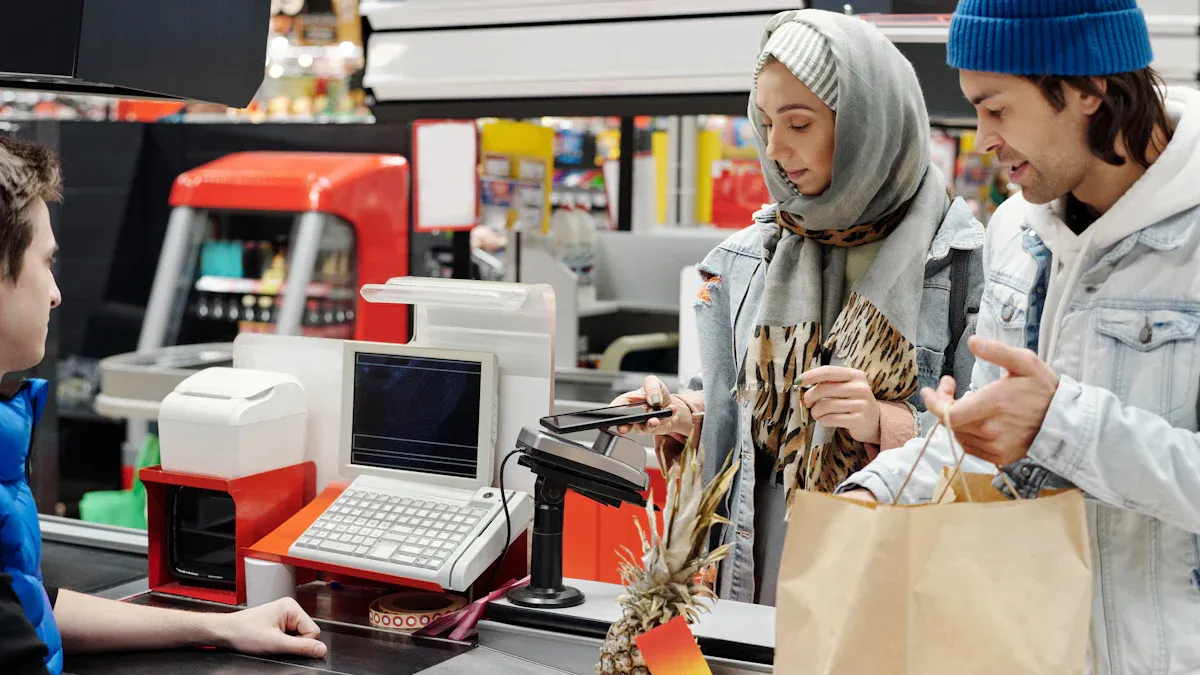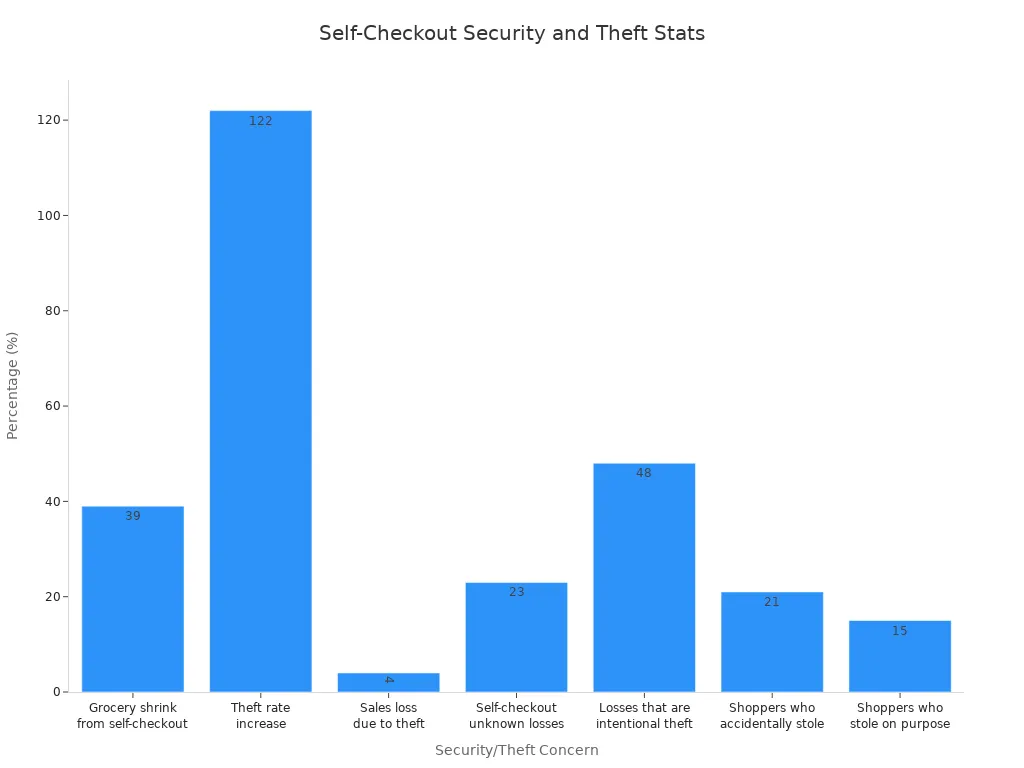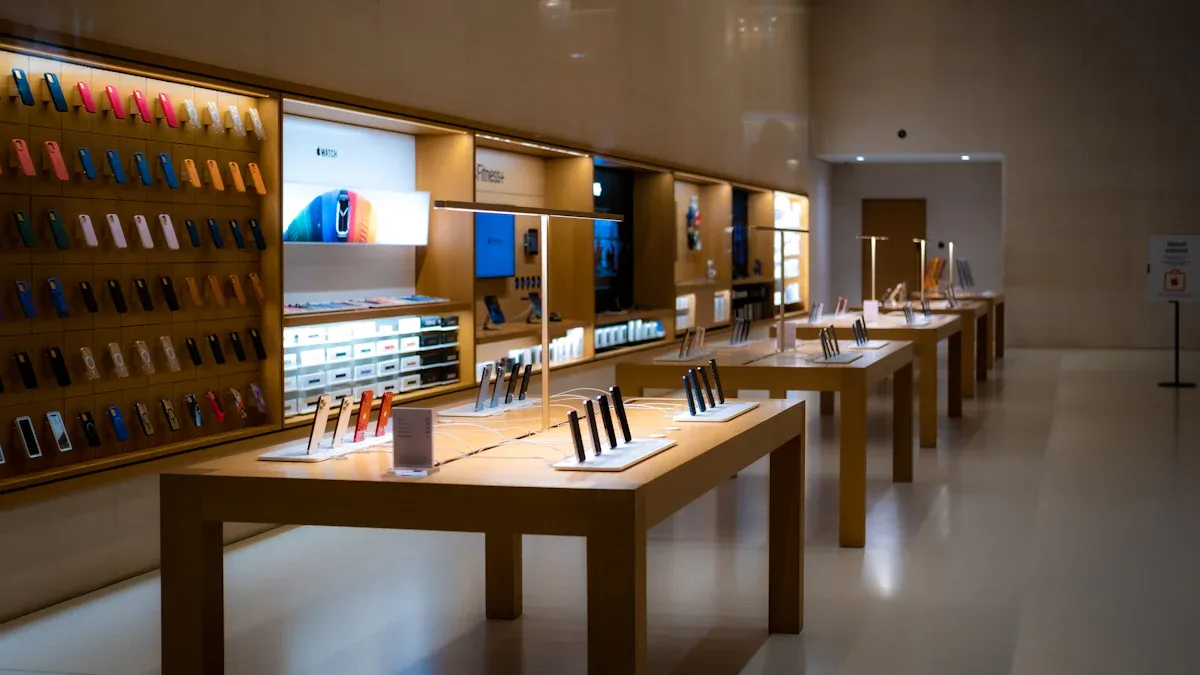Self-Checkout Evolution

You see self-checkout everywhere today. The self-checkout evolution has reshaped how you shop. Over the last ten years, stores have quickly added these systems.
Grocery chains now show a 96% adoption rate.
Experts predict the number of retailers offering self-checkout will double to over 24,000 by 2030.
The technology grows at a rate of 13.4% each year.
This rapid change brings both new opportunities and challenges for you and for businesses.
Key Takeaways
Self-checkout systems have transformed shopping, with a 96% adoption rate among grocery chains, making your shopping experience faster and more efficient.
The technology behind self-checkouts is rapidly evolving, with predictions of doubling the number of retailers using these systems by 2030, enhancing convenience for shoppers like you.
Self-checkout offers you greater control over your shopping experience, allowing you to scan, bag, and pay for items at your own pace, which can save you time.
While self-checkout provides many benefits, such as reduced wait times and cost savings for retailers, it also presents challenges like potential theft and user experience issues.
The future of self-checkout will likely include more advanced technology, such as AI and hybrid models, balancing convenience with security to improve your shopping experience.
Self-Checkout Evolution
Early Innovations
You can trace the self-checkout evolution back to the 1980s. The first self-checkout machines appeared in 1986, thanks to CheckRobot Inc. Kroger, a major grocery chain, installed these machines in a store near Atlanta, Georgia. This moment marked the start of self-serve retail as you know it today.
David R. Humble played a key role in this self-service revolution. In 1984, he watched a customer grow frustrated in a long grocery line. This experience inspired him to imagine a better way. He convinced Sensormatic Electronics Corp. to support his idea. After three years and a $5 million investment, his team built the first automated checkout machine. Kroger agreed to test it, and the first installation changed the way you shop.
Note: The first self-checkout system let you scan and bag your own groceries. This new approach aimed to reduce wait times and improve speed at checkout.
Key Milestones
The self-checkout evolution did not stop with that first machine. You can see important milestones that shaped self-serve retail over the years. Here is a table showing some of the most significant moments:
Year | Milestone Description |
|---|---|
1916 | Clarence Saunders introduced the first supermarket model, letting you pick your own goods. |
1967 | Barclays Bank launched the first ATM, bringing self-service to banking. |
1980s | Self-checkout systems emerged in retail, allowing you to scan and pay for your purchases. |
1986 | Kroger installed the first self-checkout system in Atlanta, Georgia. |
After 1986, self-serve checkouts spread quickly. Retailers saw the benefits of speed and lower labor costs. The self-checkout evolution gained momentum as more stores adopted these systems. By 2021, about 30% of all retail transactions used self-checkout. You now see self-serve checkouts in grocery stores, pharmacies, and even fast-food restaurants.
Recent Trends
Today, self-serve retail continues to change. You experience new features that make self-checkout faster and smarter. The market for self-checkout systems is growing fast. Reports show it could reach $48.3 billion by 2033. This growth comes from your demand for contactless and quick shopping.
Retailers now use advanced technology to improve self-serve checkouts. For example, the Caper Cart lets you scan items as you shop. It shows your running total and gives you personalized coupons. Weight sensors and barcode scanners help prevent mistakes and theft. Some stores use facial recognition for faster checkouts and personalized greetings. You might even pay with your fingerprint or palm in the near future.
Sam’s Club uses AI to check if you scanned all your items. Smart carts with cameras and sensors make shopping seamless. Real-time monitoring helps stores track carts and stop theft. These changes show how self-checkout evolution brings more speed and security to your shopping trips.
You see self-serve checkouts in more places than ever. Self-serve retail now includes kiosks, mobile scan-and-go, and smart vending machines. Unattended retail is growing in banks, hospitals, and airports. The shift from basic scanning to AI-powered features marks a new era in self-serve.
Tip: As self-serve becomes more common, you benefit from faster lines and more control over your shopping. Retailers collect data to improve your experience and keep stores secure.
The self-checkout evolution shows no signs of slowing down. You can expect even more changes as technology advances and self-serve retail becomes a bigger part of your daily life.
What Is Self-Checkout?

Definition
You use self-checkout when you want to buy items without help from a cashier. This system lets you control the entire checkout process. You scan each product, pay, and finish your purchase on your own. Major retailers describe self-checkout as a process with several clear steps:
Item selection and scanning: You pick your items and scan their barcodes at the self-checkout station.
Payment process: You choose how to pay. You can use cash, credit cards, or mobile payment apps.
Receipt and completion: The machine prints your receipt after you pay.
Weight check (optional): Some stations use a scale to check the weight of your items. This step helps prevent mistakes and theft.
Self-checkout gives you more control over your shopping experience. You decide how fast you move and how you pay. You do not need to wait for a cashier to scan your items or handle your payment.
Tip: If you want to avoid long lines, self-checkout can save you time and make shopping easier.
Core Features
Self-checkout systems stand out from traditional checkout lanes. You notice several key differences when you use these machines. The table below shows how self-checkout compares to the old way of checking out:
Feature | Self-Checkout Systems | Traditional Checkout Methods |
|---|---|---|
Convenience for Customers | Reduces waiting times and allows independent scanning | Requires waiting in line for a cashier |
Empowerment of Customers | You scan and bag items at your own pace | Cashiers handle scanning and bagging |
Efficiency for Businesses | Reduces labor costs and increases checkout throughput | Limited by the number of cashiers and lanes available |
Flexibility in Payment Methods | Accepts various payment options like cash, cards, mobile | Typically limited to cash and card payments |
You see that self-checkout offers more convenience and flexibility. You can scan and bag your items the way you like. Stores benefit because they need fewer cashiers and can serve more customers at once. You also get more choices for payment, including mobile wallets and contactless cards.
Self-checkout systems use technology to make shopping faster and easier. You interact with touchscreens, barcode scanners, and sometimes even cameras or sensors. These features help you complete your purchase quickly and securely. You shape your own shopping experience every time you use self-checkout.
Types of Self-Serve Checkouts
Self-serve retail gives you many ways to check out on your own. Each type of self-serve system fits different shopping needs and store layouts. Here is a quick look at the main types you will see in self-serve retail:
Type | Description |
|---|---|
Kiosks | Individual units where you scan items and pay, similar to a regular checkout lane. |
Scan-and-go | Handheld scanners or mobile apps let you scan items as you shop, making checkout faster. |
Smart Vending | Machines that use sensors and screens to let you buy snacks or drinks without a cashier. |
Hybrid Models | Systems that combine self-serve and staffed checkout, switching based on how busy the store is. |
Kiosks
You find self-serve kiosks in most grocery stores and big retailers. These machines let you scan, bag, and pay for your items by yourself. Speed matters most to shoppers like you, especially if you want to avoid long lines. Self-serve kiosks help you finish your shopping quickly and give you more control over your experience.
You can check out at your own pace.
Stores use fewer cashiers, which helps them save money.
Kiosks work well during busy times because they add more checkout options.
Tip: Self-ordering kiosks also appear in fast-food restaurants, letting you place and pay for your meal without waiting for a cashier.
Mobile Scan-and-Go
Mobile scan-and-go technology lets you use your phone to scan items as you shop. You pay through the app, so you skip the checkout line. This type of self-serve checkouts makes shopping faster and easier.
Feature/Benefit | Description |
|---|---|
Use of Smartphones | You scan items with your phone while shopping. |
Cashless Checkout | You pay in the app, so you do not need cash or a cashier. |
Speed of Service | You finish shopping and leave the store quickly. |
Enhanced Customer Experience | You get digital coupons and loyalty rewards in the app. |
Flexible Payment Methods | You can use cards, points, or other payment options. |
Smart Vending
Smart vending machines bring self-serve retail to places like offices, airports, and schools. These machines use screens and sensors to let you pick and pay for snacks or drinks. You get a tech-savvy, personal experience.
Smart vending machines track what you buy and keep shelves stocked.
Stores use the data to learn what you like and improve your choices.
You get quick service without waiting in line.
Hybrid Models
Hybrid self-serve checkouts mix self-serve and staffed checkout. You might see a lane that works as self-serve during slow times and switches to a regular checkout when the store gets busy. This model helps stores serve you faster and use staff more efficiently.
Some hybrid systems let one cashier watch over two self-serve lanes.
You can get help from staff if you need it, but you still control most of the process.
Hybrid models make self-serve retail flexible for both you and the store.
Note: Self-serve checkouts now appear in many forms, from kiosks to mobile apps. Each type helps you shop faster and gives you more choices in self-serve retail.
Business Impacts
Cost and Labor
You see self-serve retail changing how stores manage costs and staff. When you use self-serve checkout, stores need fewer cashiers. This shift helps retailers lower labor costs. Many grocery stores now reallocate their budgets to improve your shopping experience and make operations smoother. In the past, retailers tried to save money by hiring part-time workers. Today, younger workers fill many retail jobs, but self-serve systems continue to reduce the need for large teams.
Retailers can spend more on technology and customer service.
Stores save money and improve operational efficiency.
Retailers know that self-serve retail brings cost savings, but it also creates new challenges. You might notice that some customers feel frustrated with machines or need help. Stores must balance savings with customer satisfaction to make the business case for self-serve retail strong.
Operations
Self-serve retail improves how stores operate. You help speed up the checkout process when you scan your own items. Retailers report that self-serve stations make store layouts better and use space more wisely. In fact, 75% of retailers say self-serve checkout helps them organize their stores. You enjoy a smoother shopping trip, and stores serve more customers at once.
79% of retailers see a better customer experience with self-serve.
58% report lower labor costs.
51% notice improvements in operational efficiency.
Self-serve retail lets stores handle busy times with fewer staff. You get faster service, and stores keep lines short. The business case for self-serve retail grows stronger as more retailers see these benefits in their grocery stores and other locations.
Tip: Self-serve systems help stores adapt quickly to changes in customer demand.
Security and Theft
Self-serve retail brings new security concerns. When you use self-serve checkout, stores face higher risks of theft. Some customers scan expensive items as cheaper ones, like steaks as potatoes. The anonymity of self-serve makes theft easier, and some people think stealing from big companies is justified.
Here is a table showing key theft statistics in self-serve retail:
Evidence Description | Statistic |
|---|---|
Percentage of grocery shrink from self-checkout | |
Theft rate increase due to self-checkout | Up to 122% |
Estimated total sales loss due to theft | Nearly 4% |
Self-checkout systems account for total unknown store losses | 23% |
Percentage of self-checkout losses that are intentional theft | 48% |
Percentage of shoppers who accidentally stole an item | 21% |
Percentage of shoppers who stole on purpose | 15% |

You see that self-serve retail can lead to higher losses for retailers. Stores must invest in better security and smarter technology to protect their business. Grocery stores use cameras, sensors, and AI to catch theft and keep you honest.
Consumer Impacts
Convenience
You notice the convenience of self-serve retail every time you shop. Self-serve options let you skip long lines and check out at your own pace. Many shoppers, especially younger people like Gen Z and Millennials, prefer this method. A survey by NCR Voyix found that 77% of shoppers choose self-checkout because it offers faster service. You can scan and pay for your items quickly, which makes your in-store grocery shopping experience smoother.
You save time by avoiding traditional checkout lines.
You control the speed of your own transaction.
You enjoy more freedom during your shopping experience.
You can shop independently, which many people find empowering.
You benefit from the flexibility of self-serve retail in many stores.
Self-serve retail gives you more choices and makes your trips to the store easier. You see these systems in grocery stores, pharmacies, and even fast-food restaurants. Convenience remains the main reason you return to self-serve options again and again.
User Experience
Your self-checkout experience shapes how you feel about shopping. Many people appreciate the efficiency and independence that self-serve systems provide. You may feel empowered when you scan and bag your own items. Some shoppers, especially those who are neurodivergent, find self-serve retail less stressful.
Statistic | Result |
|---|---|
Yes | |
78% of U.K. consumers wanted more interaction with real people | Yes |
52% prefer self-service checkouts | Yes |
You might notice that some shoppers miss talking to cashiers. A study from Drexel University shows that customers often feel more loyal to brands that offer traditional checkout. While self-serve retail brings speed and control, it does not always increase satisfaction for everyone.
Many shoppers like the efficiency and convenience of self-serve.
Some people feel lonely or miss human contact.
Self-serve retail can make shopping easier for those who want less interaction.
Privacy
You may wonder how self-serve systems handle your personal information. Privacy concerns have grown as self-serve retail uses more technology. Some stores collect data about your purchases and habits. You might not always know how long they keep this information or who they share it with.
Retailers sometimes share your data with third parties without clear consent.
You may not know what information stores collect or how they use it.
Data from self-serve kiosks can stay in company systems for a long time.
You should stay aware of privacy policies when you use self-serve options. Ask questions if you feel unsure about how your data is handled. Self-serve retail brings many benefits, but you deserve to know how your information is used.
Pros and Cons of Self-Checkout
Benefits
You see many advantages when you use self-checkout. Stores and shoppers both benefit from these systems. The table below shows some of the main benefits:
Benefit | Description |
|---|---|
Self-checkout systems significantly decrease checkout wait times, improving customer satisfaction. | |
Improved Customer Experience | Customers prefer self-checkout for its speed, especially during peak hours, enhancing their shopping experience. |
Cost Savings for Retailers | Retailers benefit from reduced human errors and can reassign staff to more valuable roles. |
Enhanced Security | Self-checkouts are monitored, deterring theft and ensuring transaction security. |
Reduced Contact | Minimizes interaction between customers and staff, addressing safety concerns post-pandemic. |
You move through the store faster and avoid long lines. Retailers save money and can focus staff on helping you in other ways. Security features help keep your transactions safe. You also notice less contact with staff, which many people appreciate after the pandemic.
Tip: Self-checkout gives you more control over your shopping trip and helps stores run smoothly.
Challenges
Self-checkout brings some problems for both you and retailers. You may find the machines confusing or slow if the process is not easy to follow. Stores face technical issues and must train staff to help you when things go wrong. Here are some common challenges:
Integration with older store systems can be difficult.
You may struggle with user experience issues, such as finding items or scanning barcodes.
Stores need to train staff to help with troubleshooting and loss prevention.
Some shoppers feel uncomfortable with new technology.
Negative experiences can make you less loyal to a store.
You want convenience, but a poor design can make self-checkout frustrating. Tasks like searching for produce codes or fixing errors can slow you down. Retailers must listen to your feedback and improve the technology to keep you happy.
Employee Impact
Self-checkout changes the way store employees work. Staff now help you with machine problems instead of scanning items. This shift can make some workers feel less secure about their jobs. The table below shows how self-checkout affects employees:
Impact on Employees | Description |
|---|---|
You may get upset with machines, which can lead to negative interactions with staff. | |
Employee Engagement | Automated solutions can lower employee engagement if stores do not manage changes well. |
Job Insecurity | Technology makes some workers worry about losing their jobs. |
You may notice that staff spend more time helping with technical issues. Employees need new skills, such as troubleshooting and customer service. Stores must support their teams to keep morale high and make sure you get the help you need.
Trends in Self-Serve Retail

AI and Automation
You see artificial intelligence changing how you shop every day. Stores use smart technology to make self-checkout easier and faster. Many new features help you finish your purchase with less trouble. Here are some ways AI improves your experience:
Voice recognition helps you if you have trouble with touch screens. You can speak, and the system responds.
Mobile checkout lets you scan items with your phone, making shopping quicker.
Computer vision recognizes items without barcodes, so you do not need to search for codes.
Error detection finds mistakes as you scan, so you do not pay for the wrong items.
Facial recognition speeds up your payment and helps identify you.
Personalized recommendations suggest products you might like based on your shopping habits.
Fraud detection checks for suspicious activity and helps stop theft.
These tools show how self-checkout trends focus on making your shopping trip smooth and secure.
Digital Payments
You now have more ways to pay than ever before. Digital payments make self-serve retail even more convenient. You can use your phone, smart watch, or even your fingerprint to pay for your items. Many stores accept mobile wallets like Apple Pay and Google Pay. Some systems let you pay with a tap or a scan, so you do not need to carry cash or cards.
Digital payments help you check out quickly. They also keep your information safe by using encryption and secure networks. You get more control over your money and your shopping experience.
Tip: Try using a mobile wallet next time you shop. You might find it faster and easier than using cash or cards.
Security Advances
Stores work hard to keep your shopping safe. New security technologies help stop theft and protect your information. Here are some of the latest tools used in self-serve retail:
Technology/Strategy | Description |
|---|---|
Randomized Checkout Control | An algorithm picks baskets at random for extra checks. This makes it harder for people to steal. |
Automated Weight and Barcode Verification | The system checks if the weight matches the scanned items. This helps catch mistakes or theft. |
AI-Powered Cameras | Cameras watch for suspicious actions and alert security teams right away. |
These advances help stores reduce losses and keep your shopping safe. As technology grows, you can expect even better protection in the future.
The Future of Self-Checkout
Hybrid and Automated Stores
You will see more stores using both self-checkout and traditional checkout in the coming years. This hybrid model gives you more choices. Some people want to talk to a cashier. Others want to check out quickly by themselves. The hybrid approach lets you pick what works best for you.
“I don't foresee that one will dominate one or the other completely,” she said. “I think this hybrid model allows people to have the best of both worlds.”
You may notice new technology in stores. Here are some trends you will likely see soon:
Shoppable livestreams let you buy products while watching videos.
Robots help clean floors and keep track of inventory.
Cashier-less checkout uses computer vision and weight sensors to make shopping even faster.
The future of self-checkout will not look the same in every store. Some stores will use more automation. Others will keep a mix of people and machines. You will have more ways to shop and pay.
Balancing Convenience and Security
You want shopping to be easy, but you also want your purchases to be safe. Retailers use smart technology to keep your experience smooth and secure. Many stores now use computer vision AI to watch transactions in real time. This helps stop theft without needing more staff.
The system can spot strange scanning actions and alert workers right away.
AI-powered self-checkouts help you find items faster and keep the process safe.
Real-time monitoring means stores can act quickly if something seems wrong.
The future of self-checkout depends on finding the right balance. You get more convenience, but stores must protect against loss. As technology grows, you will see even better ways to shop safely and quickly.
You have seen self-checkout change shopping in many ways. The technology makes your trips faster and easier. Stores save money and learn more about what you buy. You may face challenges with using machines and keeping your information safe.
Key Aspect | Details |
|---|---|
Shopping gets easier and faster with new self-checkout technology. | |
Benefits | You save time, and stores lower costs while learning about customers. |
Challenges | Usability and safety need balance between tech and support. |
Smarter stores and new checkout ideas will shape your future shopping. | |
You can expect more innovation that balances convenience, security, and human connection. |
FAQ
What should you do if the self-checkout machine does not scan your item?
You can try scanning the barcode again. If the machine still does not work, ask a store employee for help.
Tip: Hold the barcode flat under the scanner for best results.
Is self-checkout safe for your personal information?
Stores use encryption to protect your payment data. You should check privacy policies before using self-checkout.
Security Feature | Purpose |
|---|---|
Encryption | Protects data |
Secure Networks | Blocks hackers |
Can you use cash at self-checkout stations?
Many self-checkout machines accept cash. Some only take cards or mobile payments. You should look for signs on the machine.
💡 If you need to pay with cash, choose a kiosk with a bill acceptor.
Why do stores use self-checkout?
Stores want to help you shop faster and save money on labor. Self-checkout also lets you control your own shopping experience.
Note: Retailers can serve more customers with fewer staff using self-checkout.
See Also
How Self-Checkout Systems Have Developed Over Time
Upcoming Changes to Walmart's Self-Checkout Experience in 2025
Identifying and Resolving Cash Errors in Self-Checkout
